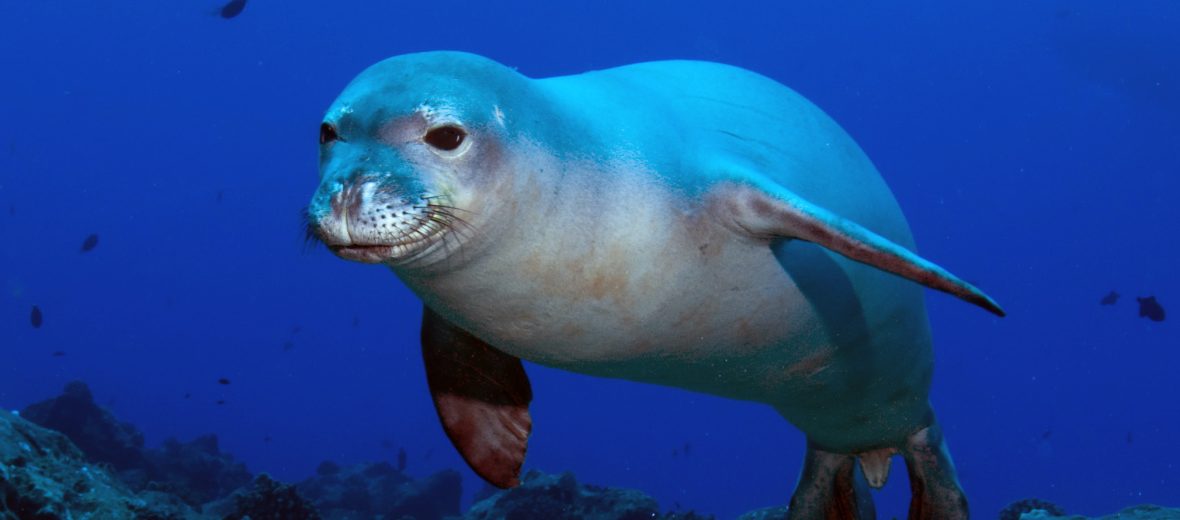
The Hawaiian monk seal is the only native Hawaiian seal and 1 of only 2 monk seal species. The other is the Mediterranean monk seal. The majority of these critters can be found among the Northwest Hawaiian Islands. But a smaller, yet growing population can be found along the primary Hawaiian Island chain. Due to overfishing; bycatch (getting caught in fishing nets); human interference via recreational activities, military exercises, and shipping lanes; which can cause vehicle strike – being hit, injured, and/or killed by vehicles); invasive species (and with them disease); pollution; and climate change, these seals are listed as Endangered by the IUCN.
First the Stats…
Scientific name: Neomonachus schauinslandi
Weight: Up to 594 lbs.
Length: Up to 7.9 feet
Lifespan: Up to 30 years
Now on to the Facts!
1.) There are only an estimated 1,300 wild individuals remaining, and overall those numbers are decreasing.
2.) At 1 time there was a 3rd species of monk seal, the Caribbean monk seal, but sadly those are now extinct.
3.) A group of seals is called a bob, colony, harem, herd, pod, or rookery.
4.) These seals are solitary and only come together to breed. That being said, they can be found, albeit appropriately separated from each other, basking in small colonies along the beaches.
5.) The Hawaiian monk seals are nocturnal (active at night).
But wait, there’s more on the Hawaiian monk seal!
6.) This seal species is considered earless. They have ears, but they just aren’t visible.
7.) These critters are not migratory, but will travel hundreds of miles in search of food.
Did you know…?
They can dive to depths of up to 1,800+ feet!
8.) Reef dwelling bony fishes, cephalopods, and crustaceans – primarily lobsters are all on the menu. This makes them, like all seals, piscivores (eat aquatic life).
9.) Hawaiian monk seals are polygynous (1 male mates with multiple females).
10.) Mating season lasts from June – August, each year.
But wait, there’s still more on the Hawaiian monk seal!
11.) Females undergo up to a 9 month gestation (pregnancy) that yields a single pup.
12.) Before birthing her pup, the female must gorge herself on food as, when the pup is born, she will not eat for up to 6 weeks; while nursing.
Did you know…?
Sans competition for food, pups also have to contend with aggressive males that mob females during mating season. This mobbing behavior can cause pup and even adult female deaths, via trampling and crushing.
13.) As soon as she is done nursing her pup, mom will desert her pup to return to the sea to feed. At this time, the pup is on its own.
14.) Both males and females are reproductively mature at 4 – 10 years of age.
15.) Pups also have to contend with other apex predators, like barracudas, jacks, and sharks for available food.
But wait, there’s still a little more on the Hawaiian monk seal!
16.) Sharks are their main predators.
17.) Besides the Hawaiian monk seals, Hawaiian hoary bats are the only other endemic mammalian species among the Hawaiian Islands.
Did you know…?
These seals can hold their breathe for up to 20 minutes.
18.) Their common name hails from the short hairs on their head which resemble a monk’s hair style.
19.) The native Hawaiians call these seals ʻIlio-holo-i-ka-uaua which translates to “dog that runs in rough water.”
20.) Each year monk seals undergo what is termed as a catastrophic molt. This is where they will shed their outer layer of skin. During this time, they remain on the beach for up to 10+ days before returning to the ocean to feed.
21.) Some Hawaiian monk seals, like manatees, will spend so much time in the ocean that algae begins to grow on their fur; giving them a green tint.
Now a Short Hawaiian Monk Seal Video!
Be sure to share & comment below! Also, check out the Critter Science YouTube channel. Videos added regularly!
Want to suggest a critter for me to write about? Let me know here.
Some source material acquired from: Wikipedia & IUCN
Photo credit: Kent Backman



